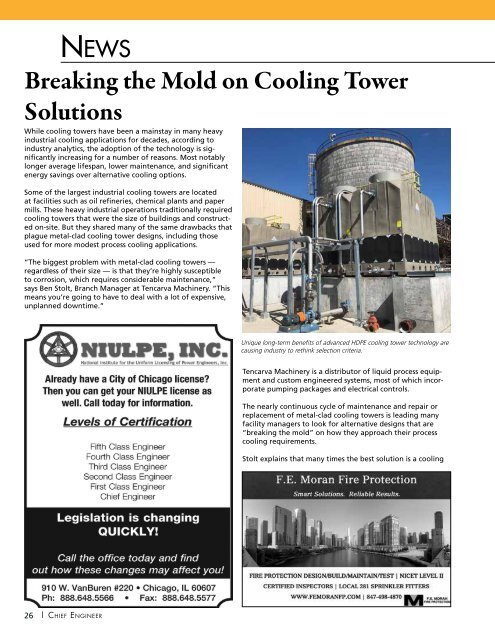CEAC-2019-10-October
You also want an ePaper? Increase the reach of your titles
YUMPU automatically turns print PDFs into web optimized ePapers that Google loves.
NEWS<br />
Breaking the Mold on Cooling Tower<br />
Solutions<br />
While cooling towers have been a mainstay in many heavy<br />
industrial cooling applications for decades, according to<br />
industry analytics, the adoption of the technology is significantly<br />
increasing for a number of reasons. Most notably<br />
longer average lifespan, lower maintenance, and significant<br />
energy savings over alternative cooling options.<br />
Some of the largest industrial cooling towers are located<br />
at facilities such as oil refineries, chemical plants and paper<br />
mills. These heavy industrial operations traditionally required<br />
cooling towers that were the size of buildings and constructed<br />
on-site. But they shared many of the same drawbacks that<br />
plague metal-clad cooling tower designs, including those<br />
used for more modest process cooling applications.<br />
“The biggest problem with metal-clad cooling towers —<br />
regardless of their size — is that they’re highly susceptible<br />
to corrosion, which requires considerable maintenance,”<br />
says Ben Stolt, Branch Manager at Tencarva Machinery. “This<br />
means you’re going to have to deal with a lot of expensive,<br />
unplanned downtime.”<br />
Unique long-term benefits of advanced HDPE cooling tower technology are<br />
causing industry to rethink selection criteria.<br />
Tencarva Machinery is a distributor of liquid process equipment<br />
and custom engineered systems, most of which incorporate<br />
pumping packages and electrical controls.<br />
The nearly continuous cycle of maintenance and repair or<br />
replacement of metal-clad cooling towers is leading many<br />
facility managers to look for alternative designs that are<br />
“breaking the mold” on how they approach their process<br />
cooling requirements.<br />
Stolt explains that many times the best solution is a cooling<br />
tower constructed of high-density polyethylene (HDPE). Offering<br />
unique long-term benefits, engineered plastic greatly<br />
reduces the need for maintenance and can also cut operational<br />
costs. He notes that many of the original HDPE towers<br />
installed back in the late 1970s are still in operation today.<br />
However, until the innovation of modular HDPE cooling tower<br />
designs, heavy industrial operations were typically stuck<br />
with metal as the only option.<br />
“With cooling capacity of up to 2,500 tons per cluster, the<br />
adoption of modular HDPE towers is accelerating in heavy industrial<br />
operations, and without all the on-site construction<br />
costs and delays,” Stolt says. “It’s a game-changer.”<br />
HDPE cooling towers also feature advanced corrosion-resistant<br />
materials, low maintenance requirements, improved<br />
energy efficiency, and longer-term warranty protection.<br />
Furthermore, the savings on installation time and money using<br />
factory pre-assembled cooling towers is likely to present<br />
another significant savings. “Compared with the construction<br />
effort required to build a large structure in the field, installing<br />
the HDPE type of cooling tower is a walk in the park,”<br />
Stolt adds. “In fact, we just installed a five-cell modular tower<br />
design in two days!”<br />
Sizing Up the Situation<br />
Recently, this scenario played itself out when Tencarva-Knoxville<br />
proposed a new cooling tower system for a major paper<br />
manufacturing operation located in eastern Tennessee. The<br />
mill was converting substantial capacity from the production<br />
of one type of paper to another, and decided that an original<br />
cooling tower structure, which was built in the 1960s — and<br />
completely rebuilt three times since — must be replaced.<br />
Gerald Kennedy, project engineer on the paper mill replacement<br />
program, said that like other manufacturers, his company<br />
management was inclined to use the basic point-of-failure<br />
philosophy servicing the towers on an as-needed basis,<br />
even though that led to repeated operational interruptions.<br />
“It was a bit frustrating to see that management was<br />
inclined to replace the existing tower structure with pretty<br />
much the same thing,” Kennedy says. “I thought there had<br />
to be a better technology that could handle our applications<br />
more efficiently.”<br />
After researching all options, the engineering team decided<br />
to replace the existing system — the oldest cooling tower of<br />
its type in the world still in service — with a modular HDPE<br />
model offering highly efficient performance as well as savings<br />
on maintenance and energy.<br />
Developed by Delta Cooling Towers (www.deltacooling.com),<br />
these HDPE engineered plastic units were designed to solve<br />
corrosion problems that plague metal towers. The corrosion<br />
can be the result of water treatment chemicals, soft water, or<br />
simply factors such as salt air or caustic industrial gasses.<br />
(Continued on page 28)<br />
<strong>10</strong>-1 Insulation<br />
Mechanical Insulation<br />
Contractor<br />
<strong>10</strong>74 W. Taylor St. Suite 169<br />
Chicago, IL 60607<br />
Jim Foster<br />
Owner/Estimator<br />
jimfoster@<strong>10</strong>-1Systems.com<br />
Mike Foster<br />
Superintendent<br />
mikefoster@<strong>10</strong>-systems.com<br />
CALL 773-807-4989 FOR AN ESTIMATE<br />
26 | Chief Engineer<br />
Volume 84 · Number <strong>10</strong> | 27


















